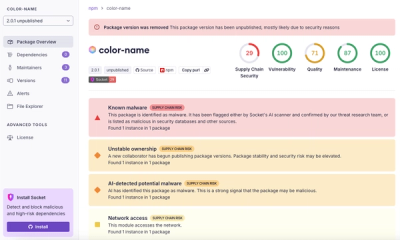
Research
/Security News
npm Author Qix Compromised in Major Supply Chain Attack
npm author Qix’s account was compromised, with malicious versions of popular packages like chalk-template, color-convert, and strip-ansi published.
github.com/fzipp/canvas
This Go module utilizes WebSockets to establish communication with a 2D canvas graphics context in a web browser, providing a portable way to create interactive 2D graphics from within a Go program.
The Go program (server) sends draw commands to the web browser (client) via WebSocket using a binary format. In return, the client sends keyboard, mouse, and touch events to the server.
This module does not rely on operating system-specific backends or Cgo bindings. It also does not utilize WebAssembly, which means the Go code runs on the server side, rather than in the browser. The client-server design enables the canvas to be displayed on a different machine over the network.
The example subdirectory contains a variety of demo programs.

The ListenAndServe function initializes the canvas server
and takes the following arguments:
the network address with the port number to bind to,
a run function,
and an options structure that configures various aspects
such as the canvas size in pixels
or a title for the browser tab.
The run function is called when a client connects to the server.
This serves as the entry point for drawing.
package main
import (
"image/color"
"log"
"github.com/fzipp/canvas"
)
func main() {
err := canvas.ListenAndServe(":8080", run, &canvas.Options{
Title: "Example 1: Drawing",
Width: 100,
Height: 80,
})
if err != nil {
log.Fatal(err)
}
}
func run(ctx *canvas.Context) {
ctx.SetFillStyle(color.RGBA{R: 200, A: 255})
ctx.FillRect(10, 10, 50, 50)
// ...
ctx.Flush()
}
After starting the program, you can access the canvas by opening http://localhost:8080 in a web browser.
The server doesn't immediately send each drawing operation to the client
but instead buffers them until the Flush method is called.
The flush should occur once the image or an animation frame is complete;
otherwise, nothing will be displayed.
Each client connection starts its own run function as a goroutine. Access to shared state between client connections must be synchronized. If you don't want to share state between connections, you should keep it local to the run function and pass the state to other functions called by the run function.
To create an animation,
you can use a for loop within the run function.
Inside this loop,
observe the ctx.Events() channel
for a canvas.CloseEvent to exit the loop
when the connection is closed.
A useful pattern is to create a struct that holds the animation state and has both an update and a draw method:
package main
import (
"log"
"time"
"github.com/fzipp/canvas"
)
func main() {
err := canvas.ListenAndServe(":8080", run, &canvas.Options{
Title: "Example 2: Animation",
Width: 800,
Height: 600,
})
if err != nil {
log.Fatal(err)
}
}
func run(ctx *canvas.Context) {
d := &demo{}
for {
select {
case event := <-ctx.Events():
if _, ok := event.(canvas.CloseEvent); ok {
return
}
default:
d.update()
d.draw(ctx)
ctx.Flush()
time.Sleep(time.Second / 6)
}
}
}
type demo struct {
// Animation state, for example:
x, y int
// ...
}
func (d *demo) update() {
// Update animation state for the next frame
// ...
}
func (d *demo) draw(ctx *canvas.Context) {
// Draw the frame here, based on the animation state
// ...
}
To handle keyboard, mouse, and touch events,
you need to specify which events the client should observe
and send to the server.
This is achieved by passing an EnabledEvents option
to the ListenAndServe function.
Mouse move events typically generate more WebSocket communication
than the others,
so you may want to enable them only if necessary.
The ctx.Events() channel receives the observed events,
and a type switch is used to determine the specific event type.
A useful pattern involves creating a handle method for event handling:
package main
import (
"log"
"github.com/fzipp/canvas"
)
func main() {
err := canvas.ListenAndServe(":8080", run, &canvas.Options{
Title: "Example 3: Events",
Width: 800,
Height: 600,
EnabledEvents: []canvas.Event{
canvas.MouseDownEvent{},
canvas.MouseMoveEvent{},
canvas.TouchStartEvent{},
canvas.TouchMoveEvent{},
canvas.KeyDownEvent{},
},
})
if err != nil {
log.Fatal(err)
}
}
func run(ctx *canvas.Context) {
d := &demo{}
for !d.quit {
select {
case event := <-ctx.Events():
d.handle(event)
default:
d.update()
d.draw(ctx)
ctx.Flush()
}
}
}
type demo struct {
quit bool
// ...
}
func (d *demo) handle(event canvas.Event) {
switch e := event.(type) {
case canvas.CloseEvent:
d.quit = true
case canvas.MouseDownEvent:
// ...
case canvas.MouseMoveEvent:
// ...
case canvas.TouchStartEvent:
// ...
case canvas.TouchMoveEvent:
// ...
case canvas.KeyDownEvent:
// ...
}
}
func (d *demo) update() {
// ...
}
func (d *demo) draw(ctx *canvas.Context) {
// ...
}
Note that the canvas.CloseEvent does not have to be explicitly enabled.
It is always enabled by default.
2D game engines:
This project is free and open source software licensed under the BSD 3-Clause License.
FAQs
Unknown package
Did you know?

Socket for GitHub automatically highlights issues in each pull request and monitors the health of all your open source dependencies. Discover the contents of your packages and block harmful activity before you install or update your dependencies.

Research
/Security News
npm author Qix’s account was compromised, with malicious versions of popular packages like chalk-template, color-convert, and strip-ansi published.

Research
Four npm packages disguised as cryptographic tools steal developer credentials and send them to attacker-controlled Telegram infrastructure.

Security News
Ruby maintainers from Bundler and rbenv teams are building rv to bring Python uv's speed and unified tooling approach to Ruby development.